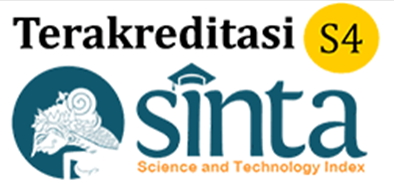Model Baru Pelayanan Administrasi Pemerintahan Daerah dalam Era New Normal di Indonesia
Abstract
This study departs from a new habit adaptation movement that changes people's social interactions as a rational choice amid the threat of the Covid-19 outbreak. The purpose of this article is to empirically test that the current model of local government administration services in the island sub-district is very inefficient and less productive so that it has an impact on meeting the basic needs of the community comfortably and equitably. Furthermore, the study offers a new model for Duo-TM, namely Face and Machine Meeting. This article demonstrates the need for empirical studies in the development of local government administrative service models to trace the difficulties and geographical risks caused by the Covid-19 outbreak. This is especially relevant if the author refers to the reasons for massive changes in various social dimensions and forces the adaptation of new habits. On the other hand, the era of the industrial revolution 4.0 places the power of technology and information as a means of innovating services that are convenient, fast, cheap, and of high quality
References
Altschuler, A., & Zegans, M. (1997). Innovation and pubic management: Notes form the state house and city hall (Innovation ini American Government ed.). (A. Altchuler, & R. Behn, Eds.) Washington, D.C: Brookings Institution.
Barrett, D. (1998). Paradox Process : Creative Business Solutions Where You Least Expect to Find Them. New York: AMACOM.
Chan, C., Lau, Y., & Pan, S. (2008). E-government Implementation : A Macro analysis of Singapore's e-government initiatives. Government Information Quarterly, 25, 239-255. https://doi.org/10.1016/j.giq.2006.04.011
Colgan, A., Rochford, s., & Burke, K. (2016). Implementing Public Service Reform - Messages from the literature. Dublin: Centre for Effective Services.
Denhardt, R. B., & Denhardt, J. V. (2000). The New Public Service: Serving Rather than. Public Administration Review, 60(6), 549–559. https://doi.org/10.1111/0033-3352.00117
Harari, Y. N. (2020, March 20). The World After Coronavirus. Retrieved from https://www.ft.com/content/19d90308-6858- 11ea-a3c9-1fe6fedcca75
Hartley, J. (2005, January). Innovation in Governance and Public Services : Past and Present. Public Money & Management, 25(1), 27-34.
Hermann, M. P., & Otto, B. (2016). Design Principles for Industrie 4.0. Presented at the 49th Hawaiian International Conference on Systems Science. https://doi.org/10.1109/HICSS.2016.488
Holgersson, J., & Karlsson, F. (2014). Public e-service development : Understanding citizens" conditions for participation. Government Information Quarterly, 31, 396-410.
Huijboom, N., Van den Broek, T., Frissen, V., Kool, L., Kotterink, B., Nielsen, M., & Millard, J. (2009). Public Services 2.0 : The impact of social computing on public services. Luxembourg: Office for official publications of the European Communities, Institute for Prospective Technological Studies, Joint Research Centre, European Commission.
Lopes, N., Soares, D., Nielsen, M., & Tavares, A. (2017). Research Gaps on Public Service Delivery. 10th International Conference on Theory and Practice of Electronic Governance (ICEGOV 2017) (pp. 465-474). New Dehli, India: ACM.
Martin, L. L., Levey, R., & Cawley, J. (2012). The “new normal” for local government. State and Local Government Review, 44(1S), 17S–28S. https://doi.org/10.1177/0160323X12440103
Mulgan, G., & Albury, D. (2003). Innovation in The Public Sector, Strategy Unit, Cabinet Office.
Ndraha, T. (2003). Kybernology (Ilmu Pemerintahan Baru). Jakarta: PT Rineka Cipta.
Ndraha, T. (2005). Kybernologi Beberapa Rekonstruksi Utama. 2005, Banten, Tangerang: Sirao Credentia Center.
Philbeck, T., & Davis, N. (2019). The Fourth Industrial Revolution: Shaping New Era. Columbia Journal of International Affairs, 72(1).
Prefontaine, L., Ricard, L., & Sicotte, H. (2000). New Models of Collaboration for Public Service Delivery: Worldwide Trends. Working paper Pivot Research Group.
Rashman, L., & Hartley, J. (2002). Leading and Learning? Knowledge transfer in the Beacon Council Scheme. Public Administration, 80, 523-542. https://doi.org/10.1111/1467-9299.00316
Robinson, M. (2015). From old Public Administration to the New Public Service: Implications for Public Sector Reform in Developing Countries. Singapore: Global Centre for Public Service Excellence.
Sacks, A., Grant, H. M., & Wilkinson, K. (2018). Te New Normal Capacity Building During a Time of Disruption. by Open Impact LLC.
Walker, R. (2004). Innovation and Performance. University of Cardiff: Cardiff Business School.
Walters, J. (2011). Governing. Firefighters Feel the Squeeze of Shrinking Budgets in small and large cities alike, firefighters have gone from heroes to budget bait.
WHO. (2020, June 6). Rolling Updates on Coronavirus Disease (COVID-19). Retrieved from https://www.who.int/emergencies/diseases/novel-coronavirus-2019/events-as-they-happen
Copyright (c) 2022 Baskara Adyaksa Lerrick

This work is licensed under a Creative Commons Attribution 4.0 International License.













